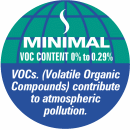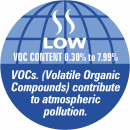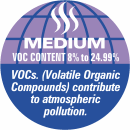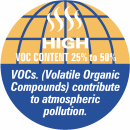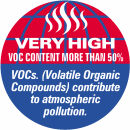VOC 2010 legislation
What is the actual name of the so-called 'VOC 2010 legislation'?
The official name of the legislation as released by the European Union is EU directive 2004/42/EC. Within UK legislation, this EU directive has been introduced under the name The Volatile Organic Compounds in Paints, Varnishes and Vehicle Refinishing Products regulations 2005. However, in the public sphere, the short version that tends to be used is 'VOC 2010 legislation'.
What is the legislation about?
VOC 2010 legislation introduces new, stricter limits on the maximum amount of VOCs that can be contained in decorative paints, stains and varnishes. Products are divided into different categories, and within each categories, different limits apply to solvent and water-based products.
This table shows you which VOC content limits apply to which product grouping:
| Product subcategory | Type | g/L VOC limit from 01/01/2010 |
|---|---|---|
| Matt coatings for interior wall & ceilings | WB SB |
30 30 |
| Glossy coatings for interior walls & ceilings | WB SB |
100 100 |
| Coatings for exterior walls of mineral substrates | WB SB |
40 430 |
| Interior/exterior trim & cladding paints for wood, metal & plastic | WB SB |
130 300 |
| Interior & exterior trim varnishes & woodstains | WB SB |
130 700 |
| Primers | WB SB |
30 350 |
| Binding primers | WB SB |
30 750 |
| One-pack performance coatings | WB SB |
140 500 |
| Binding primers | WB SB |
30 750 |
| Two-pack performance coatings | WB SB |
140 500 |
| Multi-coloured coatings | WB SB |
100 100 |
| Decorative effect coatings | WB SB |
100 400 |
- * WB = Water-based
- * SB = Solvent-based
Watch the Dulux Trade 2010 VOC Legislation video
When will the new VOC limits come into force?
The new VOC limits set out in the table above will come into force from January 1st 2010. From that date forward, non-compliant products can no longer be manufactured, however, during the whole of 2010, non-compliant products can still be sold legally.
The final cut-off date from where no more non-compliant products can be sold is January 1st 2011.
Appliers are not affected by any legal deadlines and can use up all of their non-compliant product stocks beyond 2011.
What is VOC 2010 legislation ultimately aiming to achieve?
VOC 2010 legislation seeks to reduce the amount of VOCs that are emitted by the paint industry for environmental and health reasons. VOCs contribute to air pollution and are causally linked to global warming. They also contribute to the creation of ozone in the lower atmosphere, which poses a health risk to humans, animals and vegetation. Although the paint industry is by no means the largest contributor to total VOC emissions, there is a responsibility on paint manufacturers to invest effort into reducing VOC emissions.
